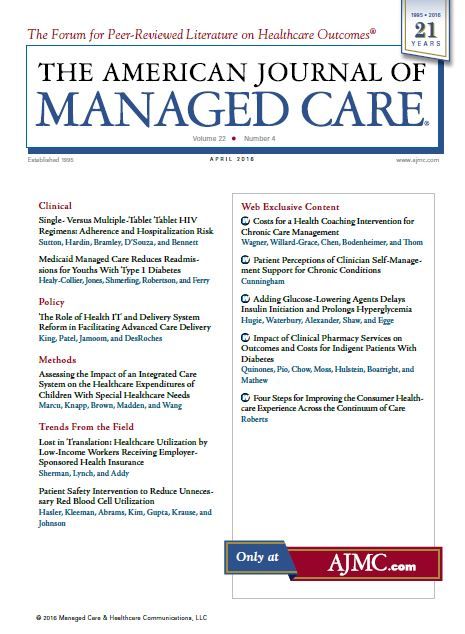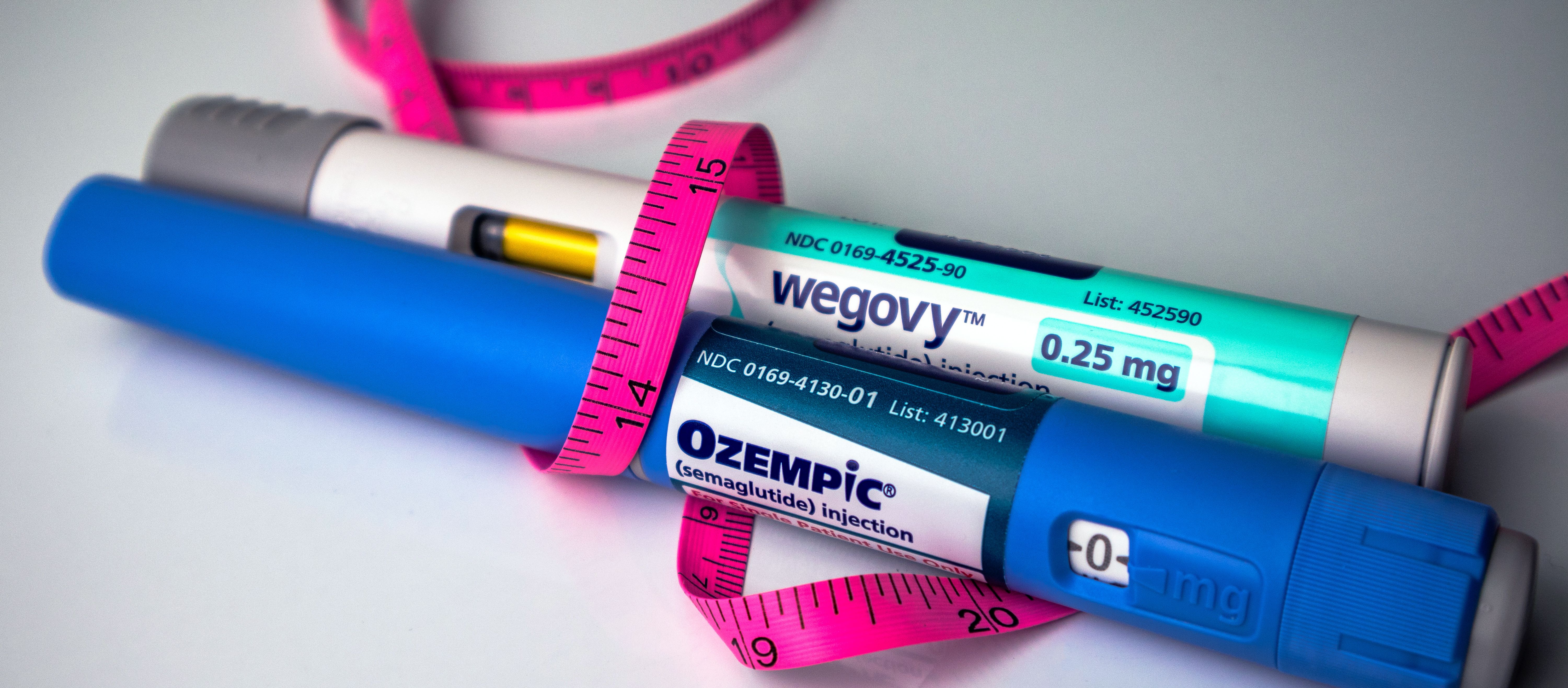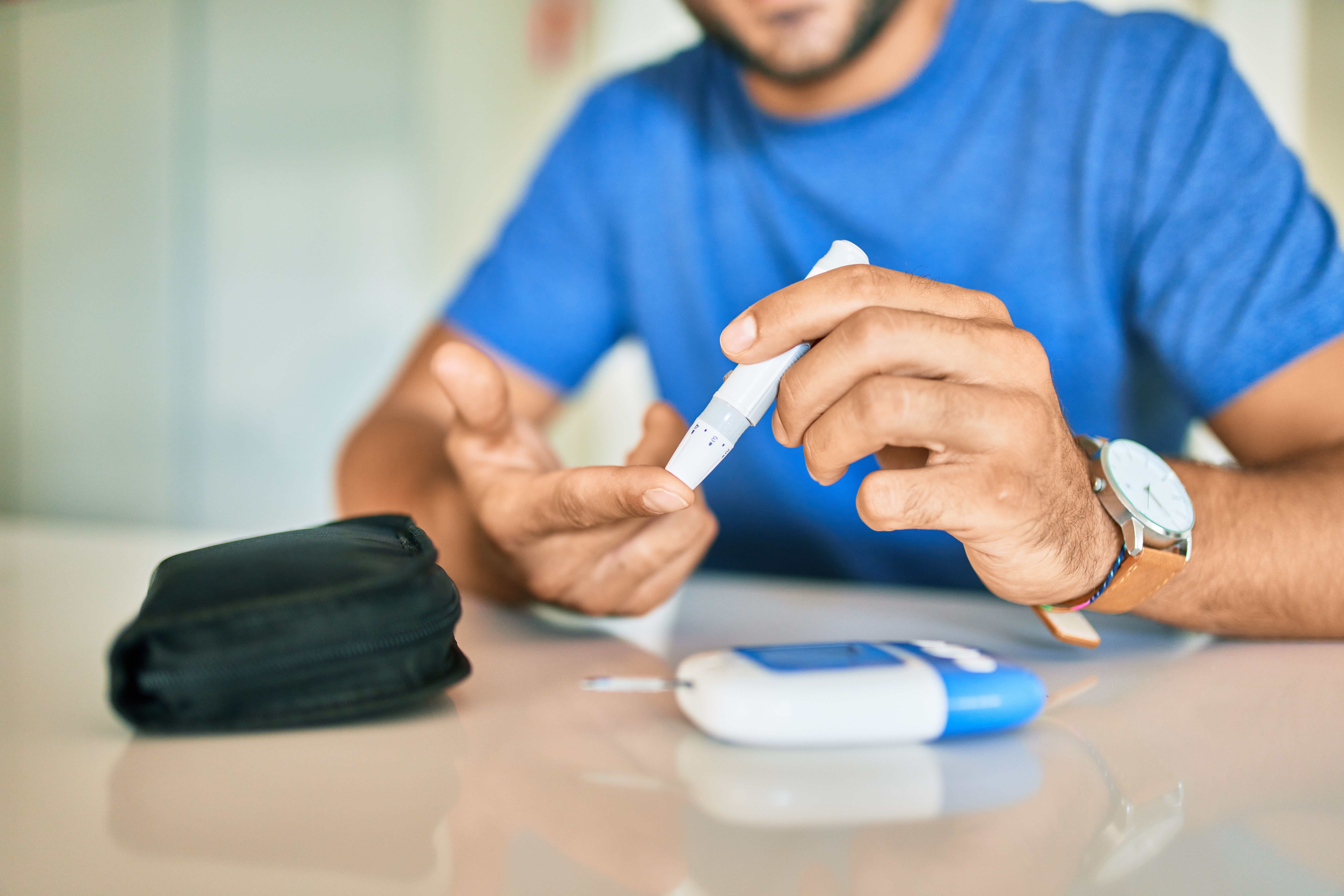Publication
Article
The American Journal of Managed Care
Impact of Clinical Pharmacy Services on Outcomes and Costs for Indigent Patients With Diabetes
Clinical pharmacy specialists impact patient care through improvements in clinical outcomes for diabetes, hypertension, and dyslipidemia via clinical interventions and promotion of medication adherence.
ABSTRACT
Objectives: To provide a review of the outcomes and costs in patients seen by Clinical Pharmacy Specialist (CPS) Certified Diabetes Educators in ambulatory care for diabetes management.
Study Design: A retrospective chart review.
Methods: All patients discharged by a CPS for diabetes management between January 1, 2010, and December 31, 2013, were included.
Results: A total of 915 patients were discharged from CPS services. The majority of patients had type 2 diabetes (98.7%) and were female (63.1%), Hispanic (53.3%), and on average, were aged 56 years. The patients were seen by the CPS for approximately 5.3 face-to-face visits, and by their provider for 1.9 face-to-face visits. The average difference from baseline for glycated hemoglobin was —2.6%, while the average systolic and diastolic blood pressures improved by –8 mm Hg and –3 mm Hg, respectively. The major lipid parameters also reported improvement, averaging –23 mg/dL for total cholesterol, –54 mg/dL for triglycerides, –15 mg/dL for low-density lipoprotein cholesterol, –23 mg/dL for non–high-density lipoprotein cholesterol (non–HDL-C), and +0.8 mg/dL for HDL-C. Overall, the average difference from baseline to final visit for the numbers and costs of medications and diabetes supplies per patient increased slightly. Medication adherence also improved each year in patients with diabetes.
Conclusions: The CPSs directly impact patient care through improvements in clinical outcomes. They help patients achieve disease-state goals for diabetes, hypertension, and dyslipidemia through a variety of clinical interventions and by promoting medication adherence. These data demonstrate the significant positive impact to the institution that clinical pharmacy services have in diabetes management.
Am J Manag Care. 2016;22(4):e147-e152
Take-Away Points
Pharmacy administrators requested information regarding the benefit of clinical pharmacy services offered at this institution. At the end of each year, information on clinical pharmacy visits were tracked and reviewed for various outcomes, including but not limited to disease-state goals, medication adherence, pharmacy interventions, and overall medication cost. A report is generated and provided to administrators in the pharmacy department, as well as presented at the hospital institution’s Pharmacy and Therapeutics Committee meetings and others to provide executive management with a review of the impact of pharmacy services offered. This article provides a review of the benefits of clinical pharmacy specialist services through improved outcomes and cost containment.Diabetes affects 25.8 million people in the United States; it is also the leading cause of kidney disease, amputations, and blindness, and a major cause of heart disease and strokes.1 Of the 25.8 million people diagnosed with diabetes in the United States, an estimated 1.8 million adults are living with diabetes in Texas.1,2 Parkland Health & Hospital System serves a large population of uninsured patients with diabetes in Dallas County. Currently, the pharmacy department employs 10 ambulatory care clinical pharmacy specialists (CPSs) who manage chronic diseases and provide drug therapy management under a collaborative practice agreement. Chronic diseases addressed include diabetes, hypertension, dyslipidemia, anticoagulation, pain, thyroid disorders, heart failure, medication nonadherence, and polypharmacy.
Patients are seen by their primary care provider (PCP) and referred to a CPS for an assessment and management of their drug therapy. A typical visit with a CPS includes a detailed medication history, review of medication allergies and side effects, and review of clinical laboratory data. With this information, the CPS provides in-person management and addresses changes to diet and exercise, documents any improvements or changes in medication adherence, and modifies medication regimens as needed for the patient. Together with the patient, the CPS provides an individualized plan to develop behavioral modification goals that will improve diabetes outcomes. They also serve as instructors of Parkland’s “Healthy Living with Diabetes” patient education program, recognized by the American Diabetes Association (ADA)3; this group of CPSs are also Certified Diabetes Educators.
Additionally, the CPSs participate in administrative duties within the pharmacy department to improve patient care in a cost-effective manner. This includes drug-use evaluations, nonformulary medication reviews, drug information consults, medication therapy management programs, Pharmacy and Therapeutics subcommittee responsibilities, and teaching pharmacy students, residents, and other healthcare professionals. Clinical research is also a major component of the CPS program, including coordinating research projects, presenting posters, and providing educational programs.
The presence of CPSs is not standard in many healthcare institutions; however, the prevalence of these clinical pharmacy positions is growing. In order to demonstrate the benefit of clinical pharmacy services, the CPS group began in 2009 to review their annual outcomes, interventions, and medication costs. At the end of each year, various data on clinical outcomes, medication adherence, pharmacy interventions, and cost are collected and reviewed for patients who have been discharged from clinical pharmacy services performed by CPSs. A report is generated and provided to administrators in the pharmacy department, as well as presented at the institution’s Pharmacy and Therapeutics Committee meetings and other meetings to provide a review of the impact of pharmacy services to executive management.
The purpose of this article is to provide a review of how the CPS demonstrates the benefit of pharmacy services through improved outcomes and cost containment in patients with diabetes in a large urban county healthcare system over a 4-year period (2010-2013).
METHODS
Patients discharged by a CPS for diabetes management between January 1, 2010, and December 31, 2013, were included in the analyses. Patients were discharged if they achieved improved diabetes control and the CPS determined the patient did not need to return for another follow-up visit. Only patients who filled medications at the institution outpatient pharmacies were included. Patient data were collected from their electronic health record. Pharmacy prescription data, adherence to medications, and cost were reviewed in the outpatient pharmacy system software program via CERNER, the institution’s ambulatory pharmacy dispensing program. Patient demographic data reviewed included age, gender, race, economic class, smoking status, level of education, past medical history, and duration of diabetes. The amount of CPS contact time was collected from the initial date of service to the date the last intervention was performed. The following types of visits were collected: CPS face-to-face visits, PCP visits, emergency department (ED) or hospital admissions for a diabetes-related event, diabetes specialty clinic visits, diabetes classes, and nutritionist visits.
Clinical outcomes related to diabetes and costs were also reported, including glycated hemoglobin (A1C), blood pressure (BP), lipid parameters, adherence to medications, and other standards of care measures.4-7 These were assessed at the initial visit and the last visit of each year for each patient. A paired 2-sample means t test using Analysis ToolPak version 14.0 (Microsoft Office Excel, Dallas, Texas) for the A1C was considered statistically significant at a P value of <.001. All interventions made by the CPS at each visit were collected, and included any medication changes, addition of aspirin, disease education, lifestyle education, identification of adverse drug events, ordering and interpreting laboratory data, smoking cessation education, pain management, immunizations, adherence counseling, use of adherence tools, and any referrals made for the patient.
The total number of medications and diabetes supplies were also reviewed at the initial and last intervention visits. Diabetes supplies included meter, strips, lancet device, lancets, alcohol prep pads, and syringes. The total cost of a 30-day supply of medications and diabetic supplies (using acquisition costs) was calculated at the initial visit and again at the last intervention visit for all patients discharged. Patients were noted to be adherent to therapy based on a review of the medication refill history from our pharmacy records in CERNER. Medication adherence was calculated as a ratio based on actual fills over expected fills for 3 months prior to the initial date of service, and was calculated again after the last intervention date. Patients were considered adherent to therapy if they met a value of 85%. The absolute difference in medication adherence was calculated to determine the improvements made by the patient at the time of discharge. There is a lack of clinical evidence and standards designating a certain threshold for adequate medication adherence, but this limit was used for the purposes of this analysis.8
RESULTS
Demographics
A total of 915 patients were discharged from CPS services from 2010 to 2013. The average age of patients seen was 56 years. The majority of patients had type 2 diabetes (98.7%) and were female (63.1%) and Hispanic (53.3%). On average, patients were seen by CPSs for 7.7 months for 5.3 face-to-face visits. The PCP also saw the patient an average of 1.9 times during the CPS intervention period. From 2010 to 2013, a total of 2 patients presented to the ED for a diabetes-related event (both for hypoglycemia), and none of the patients were hospitalized during this time period (Table 19).
Clinical Outcomes
An average difference of —2.6% from initial to final visit for A1C was noted from 2010 to 2013 (Table 2). The percentage of patients with diabetes achieving an A1C less than 7% increased significantly each year: by —2.1% in 2010, –2.7% in 2011, –2.7% in 2012, and –3.1% in 2014 (P <.001) (Figure 1). In addition, the average systolic and diastolic BPs improved by —8 mm Hg and –4 mm Hg, respectively. Overall, the major lipid parameters improved, averaging –23 mg/dL for total cholesterol, –54 mg/dL for triglycerides, –15 mg/dL for low-density lipoprotein cholesterol (LDL-C), –23 mg/dL for non–high density lipoprotein cholesterol (non–HDL-C), and +0.8 mg/dL for HDL-C (Table 2).
Medications, Adherence, and Cost
Overall, the average change in number of medications per patient from baseline to final visit increased slightly by about +0.3 medications, and the average cost increased by $1.07. The average change in the total number of diabetes supplies per patient from baseline to final visit increased slightly, by about 0.5 supplies, and the average cost of diabetes supplies increased by $4.59 (Table 2). The absolute difference in medication adherence improved at the time of discharge by 42.8% in 2010, 43.5% in 2011, 42.8% in 2012, and 49% in 2013.
Interventions and Preventative Measures
The top 5 interventions made by the CPSs included medication changes, disease-state education, ordering and interpreting lab orders, medication adherence, and referrals (Figure 2). The CPSs also ensured that patients were on medication therapies, such as angiotensin-converting enzyme inhibitors or angiotensin II receptor blockers, statin therapy, and aspirin as recommended by the ADA guidelines.4-7 The CPSs made referrals for patients to receive their annual diabetic eye exams, foot exams, and nephropathy screenings as needed.
DISCUSSION
During the 4-year review, the CPSs have been consistent in improving clinical outcomes and maintaining cost of medications in patients with diabetes who were discharged from the service. The patients discharged by a CPS from 2010 to 2013 were followed for an average of 5.3 months by the CPS. These patients had an average of 7.7 visits with a CPS and 1.9 visits with their provider. These services produced an average A1C lowering of 2.6% (Table 2). These improvements occurred when patients were treated as part of a medical team. In addition to improving diabetes outcomes, the CPSs also improved blood pressure and lipids, which are important comorbidities found in this patient population.
Additionally, CPSs improved patient medication adherence each year while containing costs of medications for the health system, noting only a small increase of 0.3 medications on average. The cost of 30-day diabetes supplies did increase slightly, by $4.59, which was most likely due to identifying more patients who needed diabetes testing supplies in order to perform self-monitoring of blood glucose. Through interventions made by the CPSs, these patients have consistently made significant improvements in adhering to their medication regimens. The CPSs help to enhance the collaborative approach in improving medication adherence that is needed for patients who are not following their medication regimens.8 In addition to improving medication adherence, the CPSs also adhere to the ADA standards of care measures for patients with diabetes. Through interventions such as medications changes, patient education, and drug therapy monitoring, ambulatory care CPSs have positively impacted the patients referred for diabetes management.
The annual review of outcomes by the CPSs serves a very important role in demonstrating the benefits of their services in this complex patient population. The outcomes demonstrate positive impacts on A1C, blood pressure, and lipid parameters. In 2007, Machado and colleagues reviewed studies evaluating pharmacists’ interventions and outcomes measured in the management of patients with diabetes. A total of 1145 patients—aged an average of 60.1 years, 53.4% female—found that the weighted average A1C decreased by 1% in a patient population managed by a pharmacist.10 In 2006, another study, by Scott and colleagues, reviewed outcomes in diabetes at a community health center and found a decrease in A1C by 1.7% at the end of a 9-month intervention period.11 This study also noted the patients’ decreased BP and LDL-C. The above studies indicate that clinical pharmacists serve major roles in the management of diabetes, and the services provided by CPSs in this review have continued to correlate to significant reductions in A1C, consistent with other study findings.12-15
Limitations
The purpose of this study was to demonstrate the benefit of CPS services at this institution. The initial CPS project was designed as a quality assurance initiative within the pharmacy department itself. Thus, limitations do exist with this analysis. This study did not include an active comparison group and, therefore, cannot determine if similar improvements in diabetes care would also exist in a control group. Additionally, this study was a retrospective review. The patient population in this review consists of those of lower economic status with various psychosocial issues, and many are without health insurance; thus, our robust results may not be reproducible with other types of patients or settings.
CONCLUSIONS
These outcomes were well received at the institution and have been a stepping stone for this CPS group. The CPSs directly impact patient care by achieving disease-state goals for diabetes, hypertension, and dyslipidemia. In addition, the CPSs have been able to contain the number and cost of medications. It is through CPS interventions, such as active and timely medication changes, patient education, and drug therapy monitoring, that this group of CPSs positively impacted the patients referred for chronic disease state management. From the results seen in this review, the CPSs continue to make consistent and positive impacts in patient care, and subsequently, this group of pharmacists has been able to demonstrate the benefit in utilizing clinical pharmacists under drug therapy management protocols at this institution.
Acknowledgments
The authors would like to acknowledge Carrie Berge, PharmD, MS, Director of Pharmacy Services, and Vivian Johnson, PharmD, MBA, FASHP, Vice President of Pharmacy Services, at Parkland Health & Hospital System for their continued support to our CPS outcomes report and the clinical pharmacy services provided at the institution. Prior presentations of study information include a poster presentation of interim results at the American College of Clinical Pharmacy Annual Meeting; Hollywood, FL; October 2012.Author Affiliations: Department of Pharmacy Services, Parkland Health & Hospital System (MEQ, MYP, DHC, EM, JLH, SMB, AM), Dallas, TX.
Source of Funding: None.
Author Disclosures: The authors report no relationship or financial interest with any entity that would pose a conflict of interest with the subject matter of this article.
Authorship Information: Concept and design (MEQ, DHC, EM, MYP, JLH, SMB, AM); acquisition of data (MEQ, DHC, EM, MYP, SMB, AM); analysis and interpretation of data (MEQ, DHC, EM, MYP, JLH, SMB); drafting of the manuscript (MEQ, DHC, MYP); critical revision of the manuscript for important intellectual content (MEQ, DHC, MYP, JLH); statistical analysis (MEQ, MYP); provision of patients or study materials (MEQ, EM, MYP, SMB, AM); administrative, technical, or logistic support (MEQ, MYP, SMB); and supervision (MEQ, EM).
REFERENCES
Address correspondence to: Marissa Escobar Quinones, PharmD, CDE, Clinical Pharmacy Specialist, Parkland Health & Hospital System, Pharmacy Administration, 5201 Harry Hines Blvd, Dallas, TX 75235. E-mail: Marissa.quinones@gmail.com.
1. National diabetes fact sheet: national estimates and general information on diabetes and prediabetes in the United States, 2011. CDC website. http://www.cdc.gov/diabetes/pubs/pdf/ndfs_2011.pdf. Published 2011. Accessed January 2013.
2. Office of Surveillance, Evaluation, and Research. Health Promotion and Chronic Disease Prevention section, Texas Department of State Health Services. The burden of diabetes in Texas. Texas Department of State Health Services website. https://www.dshs.state.tx.us/diabetes/tdcdata.shtm. Published April 1, 2013. Updated November 6, 2013. Accessed March 2016.
3. Haas L, Maryniuk M, Beck J, et al; 2012 Standards Revision Task Force. National standards for diabetes self-management education and support. Diabetes Care. 2013;36(suppl 1):S100-S108. doi: 10.2337/dc13-S100.
4. American Diabetes Association. Standards of medical care in diabetes—2010. Diabetes Care. 2010;33(suppl 1):S11-S61. doi: 10.2337/dc10-S011.
5. American Diabetes Association. Standards of medical care in diabetes—2011. Diabetes Care. 2011;34(suppl 1):S11-S61. doi: 10.2337/dc11-S011.
6. American Diabetes Association. Standards of medical care in diabetes—2012. Diabetes Care. 2012;35(suppl 1):S11-S63. doi: 10.2337/dc12-s011.
7. American Diabetes Association. Standards of medical care in diabetes—2013. Diabetes Care. 2013;36(suppl 1):S11-S66. doi: 10.2337/dc13-S011.
8. Osterberg L, Blaschke T. Adherence to medication. N Engl J Med. 2005;353(5):487-497.
9. Improving quality and patient experience: the state of health care quality 2013. National Committee for Quality Assurance website. http://www.ncqa.org/Portals/0/Newsroom/SOHC/2013/SOHC-web_version_report.pdf. Published October 2013. Accessed April 17, 2013.
10. Machado M, Bajcar J, Guzzo GC, Einarson TR. Sensitivity of patient outcomes to pharmacist interventions. part 1: systematic review and meta-analysis in diabetes management. Ann Pharmacother. 2007;41(10):1569-1582.
11. Scott DM, Boyd ST, Stephan M, Augustine SC, Reardon TP. Outcomes of pharmacist-managed diabetes care services in a community health center. Am J Health Syst Pharm. 2006;63(21):2116-2122.
12. Anaya JP, Rivera JO, Lawson K, Garcia J, Luna J Jr, Ortiz M. Evaluation of pharmacist-managed diabetes mellitus collaborative drug therapy agreement. Am J Health Syst Pharm. 2008;65(19):1841-1845. doi: 10.2146/ajhp070568.
13. Wubben DP, Vivian EM. Effects of pharmacist outpatient interventions on adults with diabetes mellitus: a systematic review. Pharmacotherapy. 2008;28(4):412-436. doi: 10.1592/phco.28.4.421.
14. Morello CM, Zadvorny EB, Cording MA, Suemoto RT, Skog J, Harari A. Development and clinical outcomes of pharmacist-managed diabetes care clinics. Am J Health Syst Pharm. 2006;63(14):1325-1331.
15. Davidson MB, Karlan VJ, Hair TL. Effect of a pharmacist-managed diabetes care program in a free medical clinic. Am J Med Qual. 2000;15:137-142.

Newsletter
Stay ahead of policy, cost, and value—subscribe to AJMC for expert insights at the intersection of clinical care and health economics.

How Can Employers Leverage the DPP to Improve Diabetes Rates?





